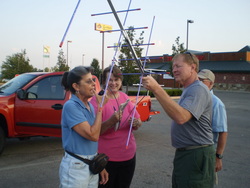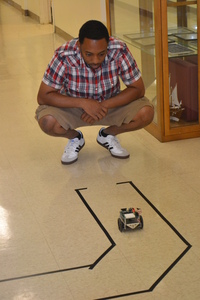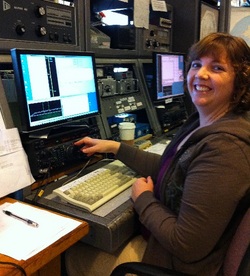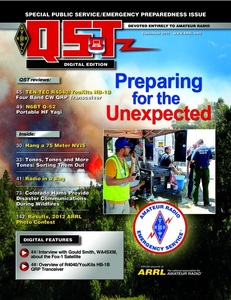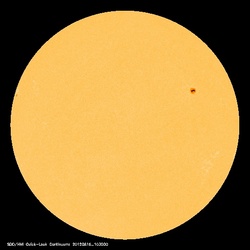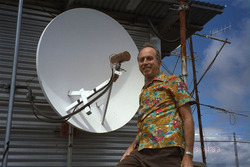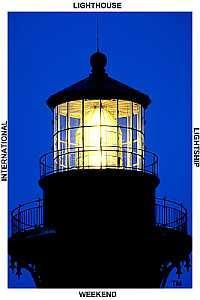 August 16, 2012 John E. Ross, KD8IDJ, Editor
| |||||||||
+ Available on ARRL Audio News. + Amateur Radio in the Classroom: ARRL Teachers Institute Offers Instructors Wireless Technology Skills for the Classroom
This summer, the ARRL offered teachers the opportunity to learn about ways to incorporate wireless technology into their classroom curriculum through its Teachers Institute on Wireless Technology (TI). Since 2004, the ARRL has sponsored TI sessions as part of its educational outreach to schools. This professional development training is offered at no cost to the teachers, but is funded through grants and donations to the ARRL's Education & Technology Program. The Teachers Institute has provided teachers from elementary school to the university level with tools and strategies to introduce basic electronics, the science of radio, space technology and satellite communications, as well as weather science, introduction to micro-controllers and basic robotics in their classrooms. The curriculum is designed for motivated teachers and other school staff who want to learn more about wireless technology and bring that knowledge to their students.
In 2012, the ARRL offered two sessions of the basic TI course (TI-1) -- held at Parallax in Rocklin, California (led by Tommy Gober, N5DUX, of Longview, Texas) and at ARRL Headquarters in Newington (led by ARRL Education and Technology Program Coordinator Mark Spencer, WA8SME, of Gales Ferry, Connecticut) -- and one session of the advanced course (TI-2), held in Dayton, Ohio (led by Matt Severin, N8MS, of Eau Claire, Michigan) and sponsored by the Dayton Amateur Radio Association. This year, 26 teachers from 17 states and a Department of Defense school in Korea participated in the TI-1 courses. At the TI-2 course, there were eight teachers from seven states. To date, almost 450 teachers have participated in the ARRL's Teachers Institute. Read more here. + NOAA Updates 2012 Hurricane Season Outlook
According to the National Oceanic and Atmospheric Administration (NOAA), the 2012 Atlantic hurricane season has been "busy," with six named storms since the season began June 1. In May 2012, NOAA forecasters originally indicated a 50 percent chance for a near-normal season in 2012, and predicted the chances for an above-normal season at 25 percent and a below-normal season at 25 percent. But on August 9, NOAA revised the chances for an above-normal season -- upping the odds to 35 percent -- while saying that the chances for a below-normal season have decreased to 15 percent. Read more here. + On the Air: RYRY Rookies -- The 2012 RTTY Rookie Roundup Is Here! On Sunday, August 19, the digital modes return to the Rookie Roundup. Created to give the budding operator a place to learn about contesting at an easier pace, the Rookie Roundup is a six hour contest open for all amateurs who have been licensed for three years or less; if you were licensed in 2010, 2011 or 2012, you qualify as a Rookie. The Rookie Roundup is run three times per year: SSB in April, RTTY in August and CW in December. By popular request, a multioperator category has been created for the Rookie Roundup. Several Rookies can operate from one location as a group. You use the same call and name in the exchange, regardless of which operator is at the keyboard. This category is perfect for clubs wanting to help their newer members get more active.
A team competition has also been created: Up to five single operator Rookies -- each operating from their own location -- can band together as a team and combine their scores. Team members are also recognized for their individual efforts, too. Multioperator entries and non-Rookies are not permitted to be on a team. Register your team up to 15 minutes before the start of the contest. Old Timers have a place in the Rookie Roundup, as well. Elmering is a critical component of the Rookie Roundup, and Old Timers are encouraged to not only get on and work the Rookies, but to host a Rookie and assist them with learning how to participate. Rookies can work anybody, but non-Rookies can only work Rookies. The contest exchange is easy: just send both call signs, your first name and your location (this is either your US state, Canadian province, Mexican call area or "DX" if you're not in the US, Canada or Mexico). Getting on RTTY has never been easier -- all you need is a PC, soundcard interface and some RTTY software to start making contacts. Veteran RTTY contester and CQ Contest Hall Of Fame member Don Hill, AA5AU, has a website geared toward the beginning RTTY op that is a wealth of info. You can log the contest using paper forms provided on the Rookie Roundup web page, or use the real-time web site at www.inthelog.com. Once the contest is over and you've calculated your score, visit the WA7BNM Rookie Roundup page to submit your score. All official entries must use this form: http://www.b4h.net/arrlrr/index.php. But don't dally -- you only have three days to submit your score summary. All score summaries must be received by 2359 UTC Wednesday, August 22, 2012. The 2012 ARRL RTTY Rookie Roundup runs from 1800 UTC through 2359 UTC Sunday, August 19, 2012. Complete rules and score submission information can be found at the ARRL Rookie Roundup website. For more information, contact ARRL Contest Branch Manager Sean Kutzko, KX9X, via e-mail. + Digital Edition of September QST Now Available The digital version of the September QST is now available to ARRL members. The digital version includes many features not available in the print version, such as:
Every issue of QST is filled with the news and features you need to keep active in Amateur Radio. The September issue of QST is our annual Public Service/Emergency Preparedness issue. Solar Update
Tad "You shone like the Sun" Cook, K7RA, reports: There was a big drop in solar activity over the past week, with the average daily sunspot numbers declining nearly 42 points to 77.6, and average daily solar flux down 20 points to 114.7. The solar flux has dropped down to 100, where it is expected to remain through August 17. NOAA/USAF is predicting the solar flux on August 18 to be 95, then 90 on August 19-22, then 105, 125 and 130 on August 23-25, and then back up to 135 on August 26-29. It is expected to drop below 100 again on September 12-15. The predicted planetary A index is 10 on August 16-17, 14 on August 18, 12 on August 19-20, then 8 on August 21, 5 on August 22-23, 8 on August 24-25, 12 on August 26, followed by 5 on August 27-September 7, then 8 on September 8-10, and down to 5 on September 11-14. This week Russ Mickiewicz, N7QR, of Portland, Oregon (and later reader David Moore) sent information on a new method for predicting solar flares that tracks decay rates in gamma radiation from radioactive elements. Look for more on the ARRL website on Friday, August 17. For more information concerning radio propagation, visit the ARRL Technical Information Service Propagation page. This week's "Tad Cookism" is brought to you by Pink Floyd's Shine On You Crazy Diamond. + Silent Key: VHF Pioneer Paul Lieb, KH6HME (SK)
Paul Lieb, KH6HME, of Hilo, Hawaii, passed away July 16. He was 84. Lieb -- an ARRL Life Member -- was best known for his VHF work and his radio beacon on the slopes of Mauna Loa where he worked the famous trans-Pacific tropo duct to the West Coast. Lieb achieved many tropo ducting distance records up through 5760 MHz and received the Dayton Hamvention Special Achievement Award in 1999 for "his pioneering and record-setting work in tropospheric ducting and VHF, UHF and microwave communications." Read more here. + On the Air: International Lighthouse/Lightship Weekend 2012
More than 400 lighthouses in almost 50 countries and territories -- from Argentina to Wales -- will be on the air for 2012 International Lighthouse/Lightship Weekend (ILLW), organized by Scotland's Ayr Amateur Radio Group (AARG). The event, held for the 15th year in a row, takes place Saturday, August 18 0001 UTC through Sunday, August 19 2359 UTC. While not a contest, the ILLW is more of a QSO Party and Amateur Radio demonstration. The ILLW aims to raise public awareness of lighthouses and lightships and the need for their preservation and restoration, promote Amateur Radio and foster international goodwill. Stations at more than 50 US lights are expected to be on the air for the event, and several stations will identify with special event call signs. Participating lighthouse/lightship stations do not have to be inside the structure or on the vessel itself; a Field Day-type setup at or adjacent to the light is sufficient. More information about the event, including a registration form and list of all lights scheduled to be on the air, is available on the ILLW website. The ILLW also has a Facebook page. This Week in Radiosport This week:
Next week:
All dates, unless otherwise stated, are UTC. See the ARRL Contest Branch page, the ARRL Contest Update and the WA7BNM Contest Calendar for more information. Looking for a Special Event station? Be sure to check out the ARRL Special Event Stations web page. Upcoming ARRL Section, State and Division Conventions and Events
To find a convention or hamfest near you, click here. ARRL -- Your One-Stop Resource for Amateur Radio News and Information Join or Renew Today! ARRL membership includes QST, Amateur Radio's most popular and informative journal, delivered to your mailbox each month. Subscribe to NCJ -- the National Contest Journal. Published bi-monthly, features articles by top contesters, letters, hints, statistics, scores, NA Sprint and QSO Parties. Subscribe to QEX -- A Forum for Communications Experimenters. Published bi-monthly, features technical articles, construction projects, columns and other items of interest to radio amateurs and communications professionals. Free of charge to ARRL members: Subscribe to the ARES E-Letter (monthly public service and emergency communications news), the ARRL Contest Update (bi-weekly contest newsletter), Division and Section news alerts -- and much more! Find us on Facebook. Follow us on Twitter. ARRL offers a wide array of products to enhance your enjoyment of Amateur Radio Donate to the fund of your choice -- support programs not funded by member dues! Click here to advertise in this newsletter. | |||||||||
